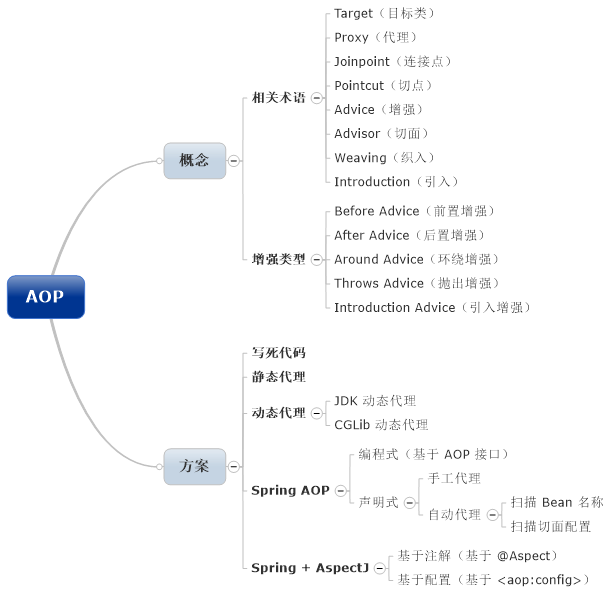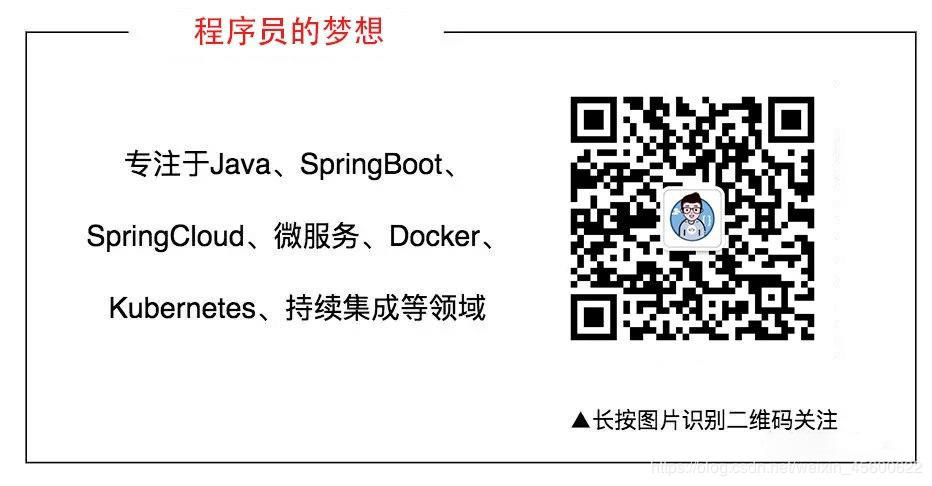详细解读 Spring AOP 面向切面编程(二)
本文是《 详细解读 Spring AOP 面向切面编程(一) 》的续集。
在上篇中,我们从写死代码,到使用代理;从编程式 Spring AOP 到声明式 Spring AOP。一切都朝着简单实用主义的方向在发展。沿着 Spring AOP 的方向,Rod Johnson(老罗)花了不少心思,都是为了让我们使用 Spring 框架时不会感受到麻烦,但事实却并非如此。那么,后来老罗究竟对 Spring AOP 做了哪些改进呢?
现在继续!
9. Spring AOP:切面
之前谈到的 AOP 框架其实可以将它理解为一个拦截器框架,但这个拦截器似乎非常武断。比如说,如果它拦截了一个类,那么它就拦截了这个类中所有的方法。类似地,当我们在使用动态代理的时候,其实也遇到了这个问题。需要在代码中对所拦截的方法名加以判断,才能过滤出我们需要拦截的方法,想想这种做法确实不太优雅。在大量的真实项目中,似乎我们只需要拦截特定的方法就行了,没必要拦截所有的方法。于是,老罗同志借助了 AOP 的一个很重要的工具, Advisor(切面) ,来解决这个问题。它也是 AOP 中的核心!是我们关注的重点!
也就是说,我们可以通过切面,将增强类与拦截匹配条件组合在一起,然后将这个切面配置到 ProxyFactory 中,从而生成代理。
这里提到这个“拦截匹配条件”在 AOP 中就叫做 Pointcut(切点) ,其实说白了就是一个基于表达式的拦截条件罢了。
归纳一下,Advisor(切面)封装了 Advice(增强)与 Pointcut(切点 )。当您理解了这句话后,就往下看吧。
我在 GreetingImpl 类中故意增加了两个方法,都以“good”开头。下面要做的就是拦截这两个新增的方法,而对 sayHello() 方法不作拦截。
@Component
public class GreetingImpl implements Greeting {
@Override
public void sayHello(String name) {
System.out.println("Hello! " + name);
}
public void goodMorning(String name) {
System.out.println("Good Morning! " + name);
}
public void goodNight(String name) {
System.out.println("Good Night! " + name);
}
}复制代码
在 Spring AOP 中,老罗已经给我们提供了许多切面类了,这些切面类我个人感觉最好用的就是基于正则表达式的切面类。 看看您就明白了:
<?xml version="1.0" encoding="UTF-8"?>
<beans ...">
<context:component-scan base-package="aop.demo"/>
<!-- 配置一个切面 -->
<bean id="greetingAdvisor" class="org.springframework.aop.support.RegexpMethodPointcutAdvisor">
<property name="advice" ref="greetingAroundAdvice"/> <!-- 增强 -->
<property name="pattern" value="aop.demo.GreetingImpl.good.*"/> <!-- 切点(正则表达式) -->
</bean>
<!-- 配置一个代理 -->
<bean id="greetingProxy" class="org.springframework.aop.framework.ProxyFactoryBean">
<property name="target" ref="greetingImpl"/> <!-- 目标类 -->
<property name="interceptorNames" value="greetingAdvisor"/> <!-- 切面 -->
<property name="proxyTargetClass" value="true"/> <!-- 代理目标类 -->
</bean>
</beans>复制代码
注意以上代理对象的配置中的 interceptorNames,它不再是一个增强,而是一个切面,因为已经将增强封装到该切面中了。此外,切面还定义了一个切点(正则表达式),其目的是为了只将满足切点匹配条件的方法进行拦截。
需要强调的是,这里的切点表达式是基于正则表达式的。示例中的“aop.demo.GreetingImpl.good.*”表达式后面的“.*”表示匹配所有字符,翻译过来就是“匹配 aop.demo.GreetingImpl 类中以 good 开头的方法”。
除了 RegexpMethodPointcutAdvisor 以外,在 Spring AOP 中还提供了几个切面类,比如:
-
DefaultPointcutAdvisor:默认切面(可扩展它来自定义切面)
-
NameMatchMethodPointcutAdvisor:根据方法名称进行匹配的切面
-
StaticMethodMatcherPointcutAdvisor:用于匹配静态方法的切面
总的来说,让用户去配置一个或少数几个代理,似乎还可以接受,但随着项目的扩大,代理配置就会越来越多,配置的重复劳动就多了,麻烦不说,还很容易出错。 能否让 Spring 框架为我们自动生成代理呢?
10. Spring AOP:自动代理(扫描 Bean 名称)
Spring AOP 提供了一个可根据 Bean 名称来自动生成代理的工具,它就是 BeanNameAutoProxyCreator。是这样配置的:
<?xml version="1.0" encoding="UTF-8"?>
<beans ...>
...
<bean class="org.springframework.aop.framework.autoproxy.BeanNameAutoProxyCreator">
<property name="beanNames" value="*Impl"/> <!-- 只为后缀是“Impl”的 Bean 生成代理 -->
<property name="interceptorNames" value="greetingAroundAdvice"/> <!-- 增强 -->
<property name="optimize" value="true"/> <!-- 是否对代理生成策略进行优化 -->
</bean>
</beans>复制代码
以上使用 BeanNameAutoProxyCreator 只为后缀为“Impl”的 Bean 生成代理。需要注意的是,这个地方我们不能定义代理接口,也就是 interfaces 属性,因为我们根本就不知道这些 Bean 到底实现了多少接口。此时不能代理接口,而只能代理类。所以这里提供了一个新的配置项,它就是 optimize。若为 true 时,则可对代理生成策略进行优化(默认是 false 的)。也就是说,如果该类有接口,就代理接口(使用 JDK 动态代理);如果没有接口,就代理类(使用 CGLib 动态代理)。而并非像之前使用的 proxyTargetClass 属性那样,强制代理类,而不考虑代理接口的方式。可见 Spring AOP 确实为我们提供了很多很好地服务!
既然 CGLib 可以代理任何的类了,那为什么还要用 JDK 的动态代理呢?肯定您会这样问。
根据多年来实际项目经验得知:CGLib 创建代理的速度比较慢,但创建代理后运行的速度却非常快,而 JDK 动态代理正好相反。如果在运行的时候不断地用 CGLib 去创建代理,系统的性能会大打折扣,所以建议一般在系统初始化的时候用 CGLib 去创建代理,并放入 Spring 的 ApplicationContext 中以备后用。
以上这个例子只能匹配目标类,而不能进一步匹配其中指定的方法,要匹配方法,就要考虑使用切面与切点了。Spring AOP 基于切面也提供了一个自动代理生成器:DefaultAdvisorAutoProxyCreator。
11. Spring AOP:自动代理(扫描切面配置)
为了匹配目标类中的指定方法,我们仍然需要在 Spring 中配置切面与切点:
<?xml version="1.0" encoding="UTF-8"?>
<beans ...>
...
<bean id="greetingAdvisor" class="org.springframework.aop.support.RegexpMethodPointcutAdvisor">
<property name="pattern" value="aop.demo.GreetingImpl.good.*"/>
<property name="advice" ref="greetingAroundAdvice"/>
</bean>
<bean class="org.springframework.aop.framework.autoproxy.DefaultAdvisorAutoProxyCreator">
<property name="optimize" value="true"/>
</bean>
</beans>复制代码
这里无需再配置代理了,因为代理将会由 DefaultAdvisorAutoProxyCreator 自动生成。也就是说,这个类可以扫描所有的切面类,并为其自动生成代理。
看来不管怎样简化,老罗始终解决不了切面的配置,这件繁重的手工劳动。在 Spring 配置文件中,仍然会存在大量的切面配置。然而在有很多情况下 Spring AOP 所提供的切面类真的不太够用了,比如:想拦截指定注解的方法,我们就必须扩展 DefaultPointcutAdvisor 类,自定义一个切面类,然后在 Spring 配置文件中进行切面配置。不做不知道,做了您就知道相当麻烦了。
老罗的解决方案似乎已经掉进了切面类的深渊,这还真是所谓的“面向切面编程”了,最重要的是切面,最麻烦的也是切面。
必须要把切面配置给简化掉,Spring 才能有所突破!
神一样的老罗总算认识到了这一点,接受了网友们的建议,集成了 AspectJ,同时也保留了以上提到的切面与代理配置方式(为了兼容老的项目,更为了维护自己的面子)。将 Spring 与 AspectJ 集成与直接使用 AspectJ 是不同的,我们不需要定义 AspectJ 类(它是扩展了 Java 语法的一种新的语言,还需要特定的编译器),只需要使用 AspectJ 切点表达式即可(它是比正则表达式更加友好的表现形式)。
12. Spring + AspectJ(基于注解:通过 AspectJ execution 表达式拦截方法)
下面以一个最简单的例子,实现之前提到的环绕增强。先定义一个 Aspect 切面类:
@Aspect
@Component
public class GreetingAspect {
@Around("execution(* aop.demo.GreetingImpl.*(..))")
public Object around(ProceedingJoinPoint pjp) throws Throwable {
before();
Object result = pjp.proceed();
after();
return result;
}
private void before() {
System.out.println("Before");
}
private void after() {
System.out.println("After");
}
}复制代码
注意:类上面标注的 @Aspect 注解,这表明该类是一个 Aspect(其实就是 Advisor)。该类无需实现任何的接口,只需定义一个方法(方法叫什么名字都无所谓),只需在方法上标注 @Around 注解,在注解中使用了 AspectJ 切点表达式。方法的参数中包括一个 ProceedingJoinPoint 对象,它在 AOP 中称为 Joinpoint(连接点), 可以通过该对象获取方法的任何信息,例如:方法名、参数等。
下面重点来分析一下这个切点表达式:
execution(* aop.demo.GreetingImpl.*(..))
-
execution():表示拦截方法,括号中可定义需要匹配的规则。
-
第一个“*”:表示方法的返回值是任意的。
-
第二个“*”:表示匹配该类中所有的方法。
-
(..):表示方法的参数是任意的。
是不是比正则表达式的可读性更强呢?如果想匹配指定的方法,只需将第二个“*”改为指定的方法名称即可。
如何配置呢?看看是有多简单吧:
<?xml version="1.0" encoding="UTF-8"?>
<beans xmlns="http://www.springframework.org/schema/beans"
xmlns:xsi="http://www.w3.org/2001/XMLSchema-instance"
xmlns:context="http://www.springframework.org/schema/context"
xmlns:aop="http://www.springframework.org/schema/aop"
xsi:schemaLocation="http://www.springframework.org/schema/beans
http://www.springframework.org/schema/beans/spring-beans.xsd
http://www.springframework.org/schema/context
http://www.springframework.org/schema/context/spring-context.xsd
http://www.springframework.org/schema/aop
http://www.springframework.org/schema/aop/spring-aop.xsd">
<context:component-scan base-package="aop.demo"/>
<aop:aspectj-autoproxy proxy-target-class="true"/>
</beans>复制代码
两行配置就行了,不需要配置大量的代理,更不需要配置大量的切面,真是太棒了!需要注意的是 proxy-target-class="true" 属性,它的默认值是 false,默认只能代理接口(使用 JDK 动态代理),当为 true 时,才能代理目标类(使用 CGLib 动态代理)。
Spring 与 AspectJ 结合的威力远远不止这些,我们来点时尚的吧,拦截指定注解的方法怎么样?
13. Spring + AspectJ(基于注解:通过 AspectJ @annotation 表达式拦截方法)
为了拦截指定的注解的方法,我们首先需要来自定义一个注解:
@Target(ElementType.METHOD)
@Retention(RetentionPolicy.RUNTIME)
public @interface Tag {
}复制代码
以上定义了一个 @Tag 注解,此注解可标注在方法上,在运行时生效。
只需将前面的 Aspect 类的切点表达式稍作改动:
@Aspect
@Component
public class GreetingAspect {
@Around("@annotation(aop.demo.Tag)")
public Object around(ProceedingJoinPoint pjp) throws Throwable {
...
}
...
}复制代码
这次使用了 @annotation() 表达式,只需在括号内定义需要拦截的注解名称即可。
直接将 @Tag 注解定义在您想要拦截的方法上,就这么简单:
@Component
public class GreetingImpl implements Greeting {
@Tag
@Override
public void sayHello(String name) {
System.out.println("Hello! " + name);
}
}复制代码
以上示例中只有一个方法,如果有多个方法,我们只想拦截其中某些时,这种解决方案会更加有价值。
除了 @Around 注解外,其实还有几个相关的注解,稍微归纳一下吧:
-
@Before:前置增强
-
@After:后置增强
-
@Around:环绕增强
-
@AfterThrowing:抛出增强
-
@DeclareParents:引入增强
此外还有一个 @AfterReturning(返回后增强),也可理解为 Finally 增强,相当于 finally 语句,它是在方法结束后执行的,也就说说,它比 @After 还要晚一些。
最后一个 @DeclareParents 竟然就是引入增强!为什么不叫做 @Introduction 呢?我也不知道为什么,但它干的活就是引入增强。
14. Spring + AspectJ(引入增强)
为了实现基于 AspectJ 的引入增强,我们同样需要定义一个 Aspect 类:
@Aspect
@Component
public class GreetingAspect {
@DeclareParents(value = "aop.demo.GreetingImpl", defaultImpl = ApologyImpl.class)
private Apology apology;
}复制代码
只需要在 Aspect 类中定义一个需要引入增强的接口,它也就是运行时需要动态实现的接口。在这个接口上标注了 @DeclareParents 注解,该注解有两个属性:
-
value:目标类
-
defaultImpl:引入接口的默认实现类
我们只需要对引入的接口提供一个默认实现类即可完成引入增强:
public class ApologyImpl implements Apology {
@Override
public void saySorry(String name) {
System.out.println("Sorry! " + name);
}
}复制代码
以上这个实现会在运行时自动增强到 GreetingImpl 类中,也就是说,无需修改 GreetingImpl 类的代码,让它去实现 Apology 接口,我们单独为该接口提供一个实现类(ApologyImpl),来做 GreetingImpl 想做的事情。
还是用一个客户端来尝试一下吧:
public class Client {
public static void main(String[] args) {
ApplicationContext context = new ClassPathXmlApplicationContext("aop/demo/spring.xml");
Greeting greeting = (Greeting) context.getBean("greetingImpl");
greeting.sayHello("Jack");
Apology apology = (Apology) greeting; // 强制转型为 Apology 接口
apology.saySorry("Jack");
}
}复制代码
从 Spring ApplicationContext 中获取 greetingImpl 对象(其实是个代理对象),可转型为自己静态实现的接口 Greeting,也可转型为自己动态实现的接口 Apology,切换起来非常方便。
使用 AspectJ 的引入增强比原来的 Spring AOP 的引入增强更加方便了,而且还可面向接口编程(以前只能面向实现类),这也算一个非常巨大的突破。
这一切真的已经非常强大也非常灵活了!但仍然还是有用户不能尝试这些特性,因为他们还在使用 JDK 1.4(根本就没有注解这个东西),怎么办呢?没想到 Spring AOP 为那些遗留系统也考虑到了。
15. Spring + AspectJ(基于配置)
除了使用 @Aspect 注解来定义切面类以外,Spring AOP 也提供了基于配置的方式来定义切面类:
<?xml version="1.0" encoding="UTF-8"?>
<beans ...">
<bean id="greetingImpl" class="aop.demo.GreetingImpl"/>
<bean id="greetingAspect" class="aop.demo.GreetingAspect"/>
<aop:config>
<aop:aspect ref="greetingAspect">
<aop:around method="around" pointcut="execution(* aop.demo.GreetingImpl.*(..))"/>
</aop:aspect>
</aop:config>
</beans>复制代码
使用 <aop:config> 元素来进行 AOP 配置,在其子元素中配置切面,包括增强类型、目标方法、切点等信息。
无论您是不能使用注解,还是不愿意使用注解,Spring AOP 都能为您提供全方位的服务。
好了,我所知道的比较实用的 AOP 技术都在这里了,当然还有一些更为高级的特性,由于个人精力有限,这里就不再深入了。
还是依照惯例,给一张牛逼的高清无码思维导图,总结一下以上各个知识点:

再来一张表格,总结一下各类增强类型所对应的解决方案:
| 增强类型 | 基于 AOP 接口 | 基于 @Aspect | 基于 <aop:config> |
| Before Advice(前置增强) | MethodBeforeAdvice | @Before | < aop:before> |
| AfterAdvice(后置增强) | AfterReturningAdvice | <aop:after > | |
| AroundAdvice(环绕增强) | MethodInterceptor | @Around | <aop:around> |
| ThrowsAdvice(抛出增强 | ThrowsAdvice | @AfterThrowing | <aop:after-throwing> |
| IntroductionAdvice(引入增强) | DelegatingIntroductionInterceptor | @DeclareParents | <aop:declare-parents> |
最后给一张 UML 类图描述一下 Spring AOP 的整体架构:


- 本文标签: classpath 配置 XML src AOP 微服务 翻译 cat Docker lib IO cglib 编译 tar 程序员 client 自动生成 Proxy java App schema bean 静态方法 spring 突破 CTO 总结 Property springcloud 正则表达式 https 代码 final 微信公众号 专注 db IDE 参数 ACE springboot tag tab UI value http id 类图
- 版权声明: 本文为互联网转载文章,出处已在文章中说明(部分除外)。如果侵权,请联系本站长删除,谢谢。
- 本文海报: 生成海报一 生成海报二











![[HBLOG]公众号](https://www.liuhaihua.cn/img/qrcode_gzh.jpg)

